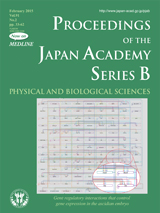About the Cover
Vol. 91 No. 2 (2015)
The ascidian embryo provides an ideal experimental system for analyzing gene regulatory mechanisms, since its genome encodes a relatively small number of regulatory genes, primarily those for transcription factors and signaling molecules, the expression patterns of which can be dissected with single-cell resolution. The blueprint for the body plan of this chordate is established during early embryogenesis, by the beginning of gastrulation. A great challenge in developmental biology is to identify gene regulatory networks and their functions, and to determine the chronological sequence of their expression. Comprehensive gene knock-down experiments in Ciona intestinalis reveal a very complex network of regulatory genes. In the present issue (pp. 33-51) the authors have updated the Ciona gene regulatory network by incorporating recently published results, mostly from their own laboratory (Figure). To what extent does this network explain combinational and integrated spatio-temporal gene expression profiles that underlie the formation of chordate body plan? The authors show that this network explains many specific gene expression patterns. At the same time, they show that the network involves a mechanism that cannot be explained as simply a combination of upstream transcription factors. What logic is hidden in the mechanism? This cover figure focuses on this major question in developmental biology.
Professor
The Okinawa Institute of Science and Technology




